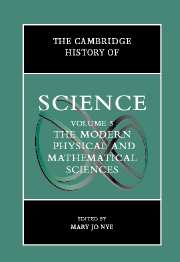Book contents
- Frontmatter
- Introduction: The Modern Physical and Mathematical Sciences
- Part I The Public Cultures of the Physical Sciences After 1800
- Part II Discipline Building in the Sciences: Places, Instruments, Communication
- 6 Mathematical Schools, Communities, and Networks
- 7 The Industry, Research, and Education Nexus
- 8 Remaking Astronomy: Instruments and Practice in the Nineteenth and Twentieth Centuries
- 9 Languages in Chemistry
- 10 Imagery And Representation In Twentieth-Century Physics
- Part III Chemistry and Physics: Problems Through the Early 1900s
- Part IV Atomic and Molecular Sciences in the Twentieth Century
- Part V Mathematics, Astronomy, and Cosmology Since the Eighteenth Century
- Part VI Problems and Promises at the End of the Twentieth Century
- Index
- References
9 - Languages in Chemistry
from Part II - Discipline Building in the Sciences: Places, Instruments, Communication
Published online by Cambridge University Press: 28 March 2008
- Frontmatter
- Introduction: The Modern Physical and Mathematical Sciences
- Part I The Public Cultures of the Physical Sciences After 1800
- Part II Discipline Building in the Sciences: Places, Instruments, Communication
- 6 Mathematical Schools, Communities, and Networks
- 7 The Industry, Research, and Education Nexus
- 8 Remaking Astronomy: Instruments and Practice in the Nineteenth and Twentieth Centuries
- 9 Languages in Chemistry
- 10 Imagery And Representation In Twentieth-Century Physics
- Part III Chemistry and Physics: Problems Through the Early 1900s
- Part IV Atomic and Molecular Sciences in the Twentieth Century
- Part V Mathematics, Astronomy, and Cosmology Since the Eighteenth Century
- Part VI Problems and Promises at the End of the Twentieth Century
- Index
- References
Summary
Language plays a key role in shaping the identity of a scientific discipline. If we take the term “discipline” in its common pedagogical meaning, a good command of the basic vocabulary is a precondition to graduation in a discipline When disciplines are viewed as communities of practitioners, they are also characterized by the possession of a common language, including esoteric terms, patterns of argumentation, and metaphors. The linguistic community is even stronger in research schools, as a number of studies emphasize. Sharing a language is more than understanding a specific jargon. Beyond the codified meanings and references of scientific terms, a scientific community is characterized by a set of tacit rules that guarantee a mutual understanding when the official code of language is not respected. Tacit knowing is involved not only in the understanding of terms and symbols but also in the uses of imagery, schemes, and various kinds of expository devices. A third important function of language in the construction of a scientific discipline is that it shapes and organizes a specific worldview, through naming and classifying objects belonging to its territory. This latter function is of special interest in chemistry.
According to Auguste Comte, the method of rational nomenclature is the contribution of chemistry to the construction of the positivistic or scientific method. Although earlier attempts at a systematic nomenclature were made in botany, the decision by late-eighteenth-century chemists to build up an artificial language based on a method of nomenclature played a key role in the emergence of modern chemistry.
- Type
- Chapter
- Information
- The Cambridge History of Science , pp. 174 - 190Publisher: Cambridge University PressPrint publication year: 2002
References
- 3
- Cited by



